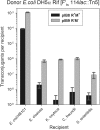Plasmid pEC156, a Naturally Occurring Escherichia coli Genetic Element That Carries Genes of the EcoVIII Restriction-Modification System, Is Mobilizable among Enterobacteria
- PMID: 26848973
- PMCID: PMC4743918
- DOI: 10.1371/journal.pone.0148355
Plasmid pEC156, a Naturally Occurring Escherichia coli Genetic Element That Carries Genes of the EcoVIII Restriction-Modification System, Is Mobilizable among Enterobacteria
Abstract
Type II restriction-modification systems are ubiquitous in prokaryotes. Some of them are present in naturally occurring plasmids, which may facilitate the spread of these systems in bacterial populations by horizontal gene transfer. However, little is known about the routes of their dissemination. As a model to study this, we have chosen an Escherichia coli natural plasmid pEC156 that carries the EcoVIII restriction modification system. The presence of this system as well as the cis-acting cer site involved in resolution of plasmid multimers determines the stable maintenance of pEC156 not only in Escherichia coli but also in other enterobacteria. We have shown that due to the presence of oriT-type F and oriT-type R64 loci it is possible to mobilize pEC156 by conjugative plasmids (F and R64, respectively). The highest mobilization frequency was observed when pEC156-derivatives were transferred between Escherichia coli strains, Enterobacter cloacae and Citrobacter freundii representing coliform bacteria. We found that a pEC156-derivative with a functional EcoVIII restriction-modification system was mobilized in enterobacteria at a frequency lower than a plasmid lacking this system. In addition, we found that bacteria that possess the EcoVIII restriction-modification system can efficiently release plasmid content to the environment. We have shown that E. coli cells can be naturally transformed with pEC156-derivatives, however, with low efficiency. The transformation protocol employed neither involved chemical agents (e.g. CaCl2) nor temperature shift which could induce plasmid DNA uptake.
Conflict of interest statement
Figures





Similar articles
-
Genetic analysis of maintenance of pEC156, a naturally occurring Escherichia coli plasmid that carries genes of the EcoVIII restriction-modification system.Plasmid. 2015 Jan;77:39-50. doi: 10.1016/j.plasmid.2014.12.002. Epub 2014 Dec 8. Plasmid. 2015. PMID: 25500017
-
Characterization of pEC156, a ColE1-type plasmid from Escherichia coli E1585-68 that carries genes of the EcoVIII restriction-modification system.Plasmid. 2001 Sep;46(2):128-39. doi: 10.1006/plas.2001.1534. Plasmid. 2001. PMID: 11591138
-
Genetic organization and molecular analysis of the EcoVIII restriction-modification system of Escherichia coli E1585-68 and its comparison with isospecific homologs.Appl Environ Microbiol. 2003 May;69(5):2638-50. doi: 10.1128/AEM.69.5.2638-2650.2003. Appl Environ Microbiol. 2003. PMID: 12732532 Free PMC article.
-
Replication and expression of constructed plasmid chimeras in transformed Escherichia coli--a review.Basic Life Sci. 1975;5A:335-44. doi: 10.1007/978-1-4684-2895-7_46. Basic Life Sci. 1975. PMID: 1103843 Review.
-
Shaping the genome--restriction-modification systems as mobile genetic elements.Curr Opin Genet Dev. 1999 Dec;9(6):649-56. doi: 10.1016/s0959-437x(99)00026-x. Curr Opin Genet Dev. 1999. PMID: 10607611 Review.
Cited by
-
Quantification of Plasmid Copy Number with Single Colour Droplet Digital PCR.PLoS One. 2017 Jan 13;12(1):e0169846. doi: 10.1371/journal.pone.0169846. eCollection 2017. PLoS One. 2017. PMID: 28085908 Free PMC article.
-
Transcriptome analyses of cells carrying the Type II Csp231I restriction-modification system reveal cross-talk between two unrelated transcription factors: C protein and the Rac prophage repressor.Nucleic Acids Res. 2019 Oct 10;47(18):9542-9556. doi: 10.1093/nar/gkz665. Nucleic Acids Res. 2019. PMID: 31372643 Free PMC article.
-
Molecular basis for lethal cross-talk between two unrelated bacterial transcription factors - the regulatory protein of a restriction-modification system and the repressor of a defective prophage.Nucleic Acids Res. 2022 Oct 28;50(19):10964-10980. doi: 10.1093/nar/gkac914. Nucleic Acids Res. 2022. PMID: 36271797 Free PMC article.
-
Low-level expression of the Type II restriction-modification system confers potent bacteriophage resistance in Escherichia coli.DNA Res. 2020 Feb 1;27(1):dsaa003. doi: 10.1093/dnares/dsaa003. DNA Res. 2020. PMID: 32167561 Free PMC article.
-
Coagulase-Negative Staphylococci Determined as Blood Culture Contamination Have High Virulence Characteristic Including Transfer of Antibiotic Resistance Determinants to Staphylococcus aureus and Escherichia coli.Int J Mol Sci. 2025 May 6;26(9):4424. doi: 10.3390/ijms26094424. Int J Mol Sci. 2025. PMID: 40362661 Free PMC article.
References
-
- Stanish VA (1988) Identification and analysis of plasmids at the genetic level. In Methods in Microbiology 2(1), pp. 11–47.
-
- Davison J (1999) Genetic exchange between bacteria in the environment. Plasmid 42:73–92. - PubMed
-
- Tock MR, Dryden DTF (2005) The biology of restriction and anti-restriction. Curr. Opin. Microbiol. 8:466–472. - PubMed
Publication types
MeSH terms
Substances
LinkOut - more resources
Full Text Sources
Other Literature Sources
Molecular Biology Databases
Research Materials

